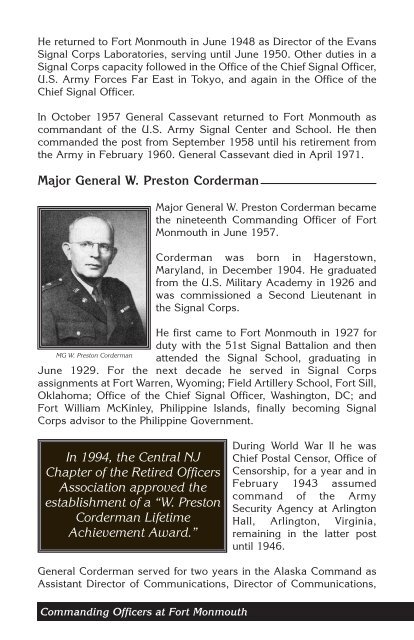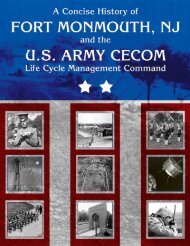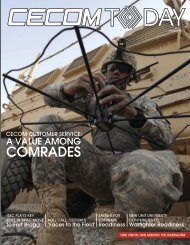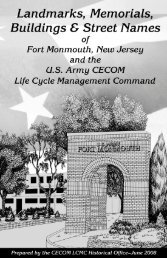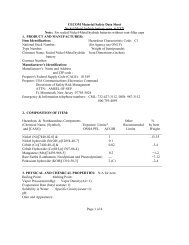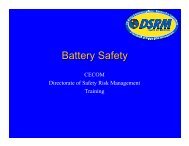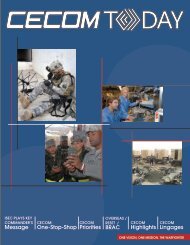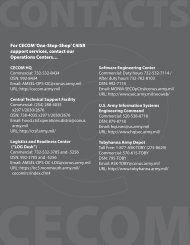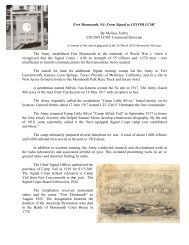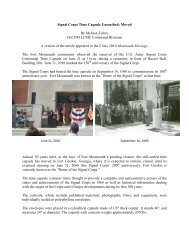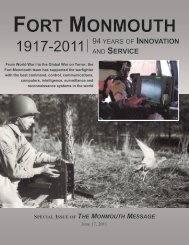A History of the Commanding Officers at Fort Monmouth ... - CECOM
A History of the Commanding Officers at Fort Monmouth ... - CECOM
A History of the Commanding Officers at Fort Monmouth ... - CECOM
Create successful ePaper yourself
Turn your PDF publications into a flip-book with our unique Google optimized e-Paper software.
He returned to <strong>Fort</strong> <strong>Monmouth</strong> in June 1948 as Director <strong>of</strong> <strong>the</strong> EvansSignal Corps Labor<strong>at</strong>ories, serving until June 1950. O<strong>the</strong>r duties in aSignal Corps capacity followed in <strong>the</strong> Office <strong>of</strong> <strong>the</strong> Chief Signal Officer,U.S. Army Forces Far East in Tokyo, and again in <strong>the</strong> Office <strong>of</strong> <strong>the</strong>Chief Signal Officer.In October 1957 General Cassevant returned to <strong>Fort</strong> <strong>Monmouth</strong> ascommandant <strong>of</strong> <strong>the</strong> U.S. Army Signal Center and School. He <strong>the</strong>ncommanded <strong>the</strong> post from September 1958 until his retirement from<strong>the</strong> Army in February 1960. General Cassevant died in April 1971.Major General W. Preston CordermanMajor General W. Preston Corderman became<strong>the</strong> nineteenth <strong>Commanding</strong> Officer <strong>of</strong> <strong>Fort</strong><strong>Monmouth</strong> in June 1957.Corderman was born in Hagerstown,Maryland, in December 1904. He gradu<strong>at</strong>edfrom <strong>the</strong> U.S. Military Academy in 1926 andwas commissioned a Second Lieutenant in<strong>the</strong> Signal Corps.He first came to <strong>Fort</strong> <strong>Monmouth</strong> in 1927 forduty with <strong>the</strong> 51st Signal B<strong>at</strong>talion and <strong>the</strong>nMG W. Preston Corderman<strong>at</strong>tended <strong>the</strong> Signal School, gradu<strong>at</strong>ing inJune 1929. For <strong>the</strong> next decade he served in Signal Corpsassignments <strong>at</strong> <strong>Fort</strong> Warren, Wyoming; Field Artillery School, <strong>Fort</strong> Sill,Oklahoma; Office <strong>of</strong> <strong>the</strong> Chief Signal Officer, Washington, DC; and<strong>Fort</strong> William McKinley, Philippine Islands, finally becoming SignalCorps advisor to <strong>the</strong> Philippine Government.In 1994, <strong>the</strong> Central NJChapter <strong>of</strong> <strong>the</strong> Retired <strong>Officers</strong>Associ<strong>at</strong>ion approved <strong>the</strong>establishment <strong>of</strong> a “W. PrestonCorderman LifetimeAchievement Award.”During World War II he wasChief Postal Censor, Office <strong>of</strong>Censorship, for a year and inFebruary 1943 assumedcommand <strong>of</strong> <strong>the</strong> ArmySecurity Agency <strong>at</strong> ArlingtonHall, Arlington, Virginia,remaining in <strong>the</strong> l<strong>at</strong>ter postuntil 1946.General Corderman served for two years in <strong>the</strong> Alaska Command asAssistant Director <strong>of</strong> Communic<strong>at</strong>ions, Director <strong>of</strong> Communic<strong>at</strong>ions,<strong>Commanding</strong> <strong>Officers</strong> <strong>at</strong> <strong>Fort</strong> <strong>Monmouth</strong>


